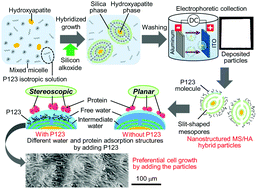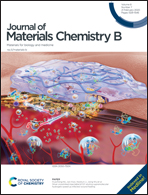Synthesis of nanostructured silica/hydroxyapatite hybrid particles containing amphiphilic triblock copolymer for effectively controlling hydration layer structures with cytocompatibility†
Abstract
We synthesized nanostructured mesoporous silica (MS)/hydroxyapatite (HA) hybrid particles in the presence of amphiphilic poly(ethylene oxide)–poly(propylene oxide)–poly(ethylene oxide) (PEO20PPO70PEO20) triblock copolymer (P123). The particles exhibited slit-shaped mesostructures and underwent hybridization reaction between the MS and HA phases containing P123. Furthermore, the aggregated form of the particles exhibited dispersion stability in water in the monodispersed state (average particle size: 145 nm and coefficient of variation: 4.3% in the case of the maximum added amount of P123). Then, the structures of the hydration layer and the adsorbed protein on the particles were investigated to understand the effect of the hydration layer structures on the protein secondary structures. The ratio of the bonding water (intermediate and nonfreezing water) to free water increased upon hybridization, and it decreased with increasing P123 concentration. Upon hybridization, the component ratio of the asymmetric O–H stretching vibration between free water molecules decreased, and that of the symmetric O–H stretching vibration of intermediate water molecules increased. With increasing P123 concentration, the asymmetric O–H stretching vibration between free water molecules increased and the symmetric O–H stretching vibration of intermediate water molecules decreased. It was found that the protein native state component ratios of α-helix and β-sheet increased with increasing symmetric O–H stretching vibration between intermediate water molecules, and they decreased with decreasing asymmetric O–H stretching vibration between free water molecules. Moreover, the cytotoxicity against osteoblasts (MC3T3-E1) was evaluated and the hybrid particles exhibited a high cell density, indicating their bioactivity. On the hybrid particles interacting with P123, the cells were three-dimensionally assembled and uniaxially grown with the culture. Therefore, this is the first successful report of the synthesis of nanostructured MS/HA hybrid particles interacting with P123, and the controlled hydration layer structures on the particle surfaces were found to contribute to the protein secondary structures, promoting cytocompatibility.



 Please wait while we load your content...
Please wait while we load your content...